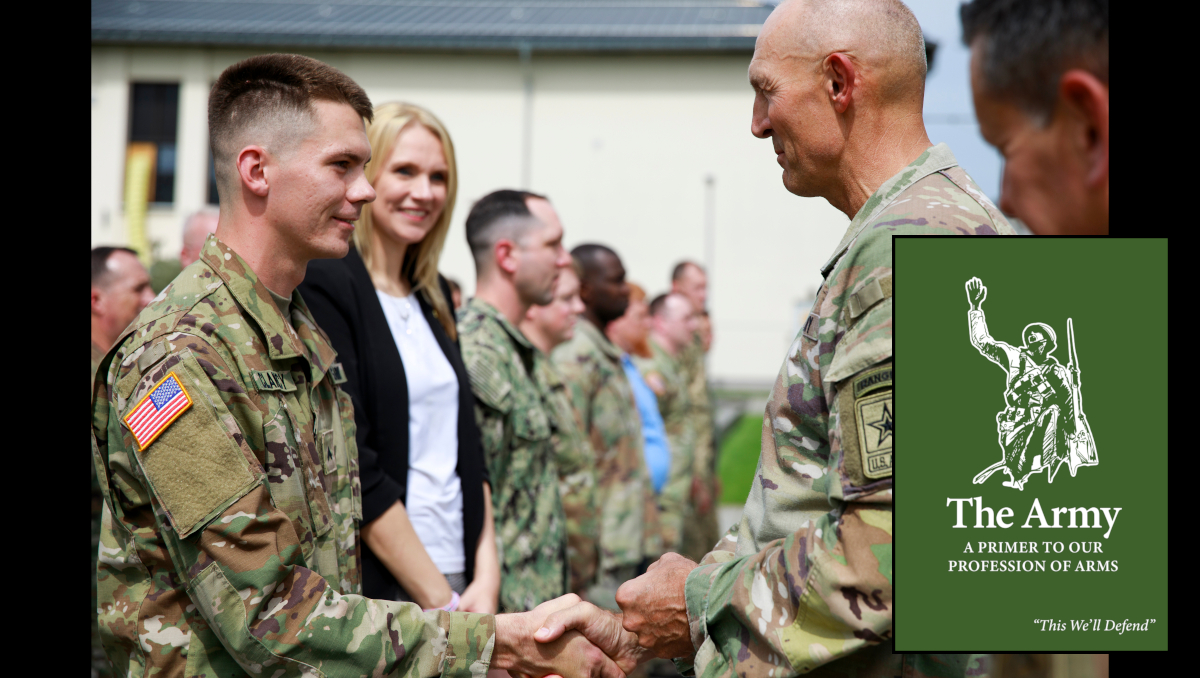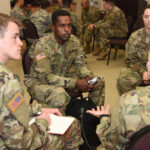
FM 1 reflects the Army’s enduring ethos—rooted in trust, character, and constitutional duty.
In May 2025, the U.S. Army released a new edition of Field Manual 1: The Army – A Primer to Our Profession of Arms. General Randy George, Chief of Staff of the Army, notes in the foreword that FM 1 “is written for our Army” and it explains the Army as a profession, its purpose, and what it means to be an American soldier. FM 1 reflects the Army’s enduring ethos—rooted in trust, character, and constitutional duty. This is not doctrine in the traditional sense but a narrative declaration of who we are as soldiers and why our service matters.
As a career soldier approaching 30 years of service, this version of FM 1 resonated with me in a fundamental way. Looking back on my career, I found myself reflecting on the role this publication might play at different stages of a soldier’s career: from understanding the Army’s ethos and culture, to inspiring one to build and lead teams capable of working with a range of partners, to reminding them of the Army’s and their obligations to their fellow citizens and the Nation. Ultimately, FM 1 is not merely a publication—it is an embodiment of the Army’s professional conscience in print and an inspiration to live up to the example of those who have gone before.
FM 1 – An Overview
Billed as a “primer to our profession of arms” and written for every soldier, FM 1’s themes should speak to aspiring soldiers as well as those simply wishing to understand the Army. Departing sharply from the 2005 version, FM 1 adopts an unconventional, reflective, and narrative-driven tone. Decidedly non-doctrinal, this style effectively engages the reader. FM 1 provides a values-based ethos that demands judgment in its application rather than a checklist for compliance.
The manual comprises ten concise, story-driven chapters across 74 pages. It is organized into three broad sections: what it means to be a soldier, what the Army does, and the Army’s obligations to teammates, leaders, and citizens. Each chapter incorporates historical vignettes that humanize the profession and should inspire readers to carry forward the legacy of those who served before them.
FM 1 describes the soldier as a warrior, a professional, and a leader. These roles are integral to a soldier’s identity, demanding grit, discipline, moral courage, and an “indefatigable force of will.” In describing what the Army does, FM 1 reaffirms that warfighting remains our most critical task, but that our contributions go beyond battle, encompassing defense support to civil authorities, humanitarian assistance, and strategic deterrence.
The manual emphasizes the soldier as the Army’s most important weapon system. It declares the Army focuses on “equipping the man,” not simply manning the equipment. This requires soldiers to be fit, lethal, disciplined, and adaptive. The American soldier makes up the Army and, when well trained and led, ensures the Army will achieve its mission.
FM 1’s final chapters stress the Army’s enduring obligations to its teammates, civilian leaders, and fellow citizens. Here, the manual underscores that the Army’s legitimacy flows from trust—trust within the ranks, with civilian authorities, and with the American people. That trust, the manual reminds us, forms the foundation of our profession.
Enduring Relevance Across a Soldier’s Career
As a foundational document, FM 1 is essential reading for new soldiers and those seeking to understand the Army ethos and culture. However, the manual applies across the entire arc of a soldier’s career.
Reading FM 1 brought me back to my first assignment as a second lieutenant. Trained but untested and now responsible for leading non-commissioned officers and soldiers with far more experience. Mentally and physically ready but yet uncertain if I would measure up. Like Sergeant First Class Michael Tackett, that seasoned NCO who took the time to mentor me, FM 1 serves as a guide to what a leader is and does, providing a clear articulation of expectations.
For freshly minted Second Lieutenant Metcalf, and all soldiers new to the profession, FM 1 serves as a “welcome letter” and introduction to the profession. FM 1 provides grounding—a sense of identity and values to navigate the inevitable challenges of Army life. It reinforces that being a soldier means mastering the warrior tasks while embodying restraint, courage, and ethical judgment.
Perhaps most importantly, FM 1’s historical vignettes connect today’s soldiers with those who came before—those such as Master Sergeant Gary Gordon and Sergeant First Class Randy Shugart, Captain Ben Salomon, or Corporal Alvin York. Their stories are more than lore—they are examples to emulate and sources of strength when adversity strikes. Looking back with the benefit of experience, I appreciate more than ever a theme linking these vignettes: the critical importance of putting your soldiers first and remaining calm in a crisis.
Almost a decade later, now a combat-tested and experienced captain, I deployed my unit from Germany to an exercise in South Korea. Trusted by my boss, I was granted significant freedom of action to accomplish the mission of deploying, drawing war stocks, and conducting a live-fire exercise. I remember the sense of empowerment and pride this gave me, and FM 1 reminded me how that empowerment is earned.
Reading FM 1, I thought of my younger self and reflected on the personal and professional values that are especially essential to mid-career soldiers and leaders. Those values are essential as your scope of responsibility and impact as a leader grow. At this point in your career, doing what is right regardless of the consequences is expected. A commitment to developing subordinates while embracing and encouraging disciplined initiative, as well as building effective teams, is essential. To that end, three themes from FM 1 are especially relevant: ethical leadership, mission command, and team building.
Ethical leadership is a persistent theme throughout the manual. The Army expects leaders to not only know what right looks like—but to model it, enforce it, and develop it in others. The story of Major George C. Marshall risking his reputation by challenging General John J. Pershing, despite his mind appearing made up, is just one example highlighted in this manual. FM 1 challenges non-commissioned officers and junior officers to reflect on figures like George Marshall and lead with moral courage. This is particularly important as one moves into positions at the operational or strategic level where speaking truth to power is not always welcomed and can come with a cost.
Given the conditions expected in large-scale combat operations, FM 1 rightly reminds us that leaders are not entitled to empowerment but rather earn it through competence and trust.
The manual’s treatment of mission command is especially insightful as the Army prepares for large-scale combat operations. These operations will differ markedly from the Global War on Terror with its permissive operating environments and large command posts, which allowed leaders to exert unprecedented levels of control on events. A future conflict with a peer adversary will likely be very different with every domain contested, fires applied at depth, and subordinates required to execute disciplined initiative in real-time.
Given the conditions expected in large-scale combat operations, FM 1 rightly reminds us that leaders are not entitled to autonomy but rather earn it through competence and trust. Leaders must develop subordinates who can execute with initiative and judgment thus earning the trust that is essential to mission command. Here, I recall particularly my time as a troop commander, developing trust up and down the chain of command through competence, consistency, and communication over time.
FM 1 also emphasizes a team-centric perspective. Warfighting is a collective endeavor, and leaders must forge cohesive, lethal, and disciplined teams that can perform effectively both individually and in conjunction with joint, interagency, and multinational partners. This is particularly true for leaders in the middle of their careers who must increasingly work with a range of partners from outside their organization.
Once again, FM 1 reminded me of my mid-career staff officer time working across the countering weapons of mass destruction, special operations forces, and interagency communities. Lacking command or directive authority, I found that demonstrating competence and taking a team-centric approach, which valued collaboration, communication, and the unique perspective each stakeholder brought to addressing a problem was essential to creating effective teams.
Late in my career, as a lieutenant colonel and colonel, I had the opportunity to serve as a strategist and strategic advisor at multiple three- and four-star commands. Broadly educated and experienced at this point, I would find FM 1’s reminder of the Army’s, and thus our senior leaders’, obligations to policymakers particularly relevant.
At senior levels, FM 1 reinforces the moral obligations of advising policymakers while owning the missions entrusted to the force. Leaders must provide candid advice, but they must also accept that policymakers ultimately decide. Once a policy decision is made, military leaders must own the mission and act with clarity, professionalism, and decisiveness to achieve it.
As a former commander’s action group director, and thus part of the “inner circle,” I have seen this in action and am confident in the Army’s senior leaders’ ability to do this. Providing military advice is an art. It should be grounded in analysis but informed by experience and judgment. It must be tailored to the audience and their preferred method of receiving information. Finally, it must provide context but be clear and succinct. Ultimately, it should be viewed as an opportunity to inform and influence, yet simply as advice, since, as FM 1 reminds us, the decision is for policymakers to make.
Importantly, FM 1 reminds us that war involves risk, and failure is possible. Senior military leaders must communicate the risks and provide policymakers with a range of feasible options. Similarly, senior leaders must ensure that soldiers understand they are responsible for the mission, not the policy, and that even when policy fails, their sacrifice is not in vain as they serve the American people. Clear, consistent messaging to subordinates is key here to ensure they understand that, ultimately, it is our job to be whatever our Nation needs us to be.
FM 1 also reminds senior leaders that their example sets the tone for the force. Upholding the Army’s apolitical character, modeling disciplined decision-making, and cultivating institutional trust is not optional. They are essential for maintaining legitimacy in the eyes of the civilian leadership and the Nation.
Conclusion
FM 1 is more than a field manual—it renders the Army’s character, culture, and conscience in print. All who lead, serve, or steward the profession of arms will find wisdom and inspiration in this work. FM 1 offers soldiers a moral compass and a professional north star in a time of uncertainty.
While written for the Army, FM 1 applies to a much broader range of readers. Civilians and those who partner with the Army would benefit from understanding the Army’s culture and ethos. For other militaries, FM 1 offers something to emulate—an organization with an unwavering commitment to the Constitution, ethical leadership, disciplined initiative, and a readiness to fight the Nation’s wars.
“This We’ll Defend” is not just a motto but a charge. FM 1 gives that charge meaning. And for soldiers past, present, and future, it reminds us all of why we serve.
Chase Metcalf is a colonel, an Army strategist and an instructor at the U.S. Army War College. He most recently served as Deputy Director of the Russia Strategic Initiative at the United States’ European Command.
The views expressed in this article are those of the author and do not necessarily reflect those of the U.S. Army War College, the U.S. Army, or the Department of Defense.
Photo Description: Then Vice Chief of Staff of the U.S. Army, and acting Chief of Staff of the U.S. Army, General Randy George shakes hands with a U.S. Army Soldier at Clay Kaserne, Wiesbaden, Germany, Aug. 24, 2023.
Photo Credit: U.S. Army photo by Thomas Mort





Colonel Metcalf,
Including your personal career trajectory underscores the relevance “This We’ll Defend” has for all ranks (and all Americans).
Thanks for reminding me to add this to my reading list ASAP. To that end, I was able to find it for free online, as well as on Amazon in hardcover, paperback, and Kindle formats.
The vast majority of the chapter beginnings, of FM-1, seem to provide cases/examples of acts of bravery and/or valor by certain military personnel; these such acts of bravery and/or valor, accordingly, most likely causing these cited military personnel to be recognized by awards and decorations containing a “V” device.
This would seem to indicate, to most soldiers reading FM-1, that (a) being a “warrior,” this means (b) being someone who has been, and/or is, engaged in acts of bravery and valor and, thus, means (c) being someone who has received/will receive a medal and/or award with a “V” device.
Yet the vast majority of professional soldiers, regardless of rank and/or time in service, will have very few (if indeed any) medals/awards containing a “V” device. Yet these exact same professional soldiers (to include E-9s, CW4s, and four star generals; some with 30 or more years of service) will have numerous (non-warrior-like?) awards and decorations for, shall we say, exceptional/exemplary military service/exceptional performance of (non-valorous) military duties.
Accordingly, should not the chapter beginnings of FM-1 have — in place of the exceptionally rare (in comparison to the normal duties and responsibilities of soldiers) valor/heroism examples — rather have, in their place, chapter beginnings which depict examples of the exceptionally more common occurrence of soldiers receiving awards for exceptional performance of their (less-warrior-like/less-valorous?), more normal, duties and responsibilities?
If not, then one is likely to have, by way of the new FM-1, communicated to soldiers (officers, warrant officers and enlisted; young, old and regardless of time in service and/or accomplishments therein) that (a) they are only “warriors” if (b) they have engaged in combat actions which has caused them to receive an award with a “V” device/an award for heroism/valor. (Something that many/most of these, otherwise outstanding and exceptionally contributing soldiers, may never receive?)
Note that, by using chapter beginning which mostly depict stories of soldiers who have received awards for certain acts of heroism/valor (which, of course, includes certain awards which do not include a “V” device; big mistake by me above); by doing this, one may also cause soldiers to use less care/to “throw caution to the wind;” this, in the hopes of proving that they are, indeed, “warriors?”
In additional the matters that I present in my initial comment above, consider the following from Chapter 1 (“A Warrior”) and the major section therein entitled “Warrior Competencies” (at Page 3):
“Every Soldier must know how to fight—to shoot, move, communicate, and render
first aid in battle. That is why every Soldier, no matter their specialty, learns these
things in their initial training. In our Army, cyber technicians, truck drivers, and
cooks all learn how to fire a weapon, throw a grenade, react to contact, program a
radio, and tighten a tourniquet. Every one of them is tested on their physical
strength and cardiovascular fitness.
These and many other skills are basic warrior tasks and an essential element of our
Soldier training. This must be ingrained into the hearts of Soldiers through
grueling, realistic training in the rain, mud, snow, and oppressive heat. What is
more, they support basic leader competencies, which include planning,
employment of fires, and leading troops.”
Question: Other than in basic training, how many times, say per quarter, do ALL soldiers receive instruction, training/refresher training, etc. — on shooting, moving and communicating, on rendering first aid (and on “many other skills”) — on how to better fire their weapon, on how to better throw a grenade, on how to better react to contact, on how to program and use a radio, on how to employ and tighten a tourniquet — and how many times, say per quarter, do ALL soldiers receive “grueling, realistic training in the rain, mud, snow, and/or oppressive heat?”
Herein one might suggest that — IF the true goal of the U.S. Army — and the true requirement of America’s citizens — is to have our soldiers be “warriors,” THEN the training that I ask about above, this would seem to be required/would seem to need to planned, prepared for, accomplished, evaluated and improved upon (a) in every Army organization (b) quarterly or at least semiannually?
Lacking this, then every soldier coming into the Army today — and every American citizen existing today — may normally see — and thus may reasonably ask — (a) why the “warrior” rhetoric found in FM-1 and elsewhere, (b) why this is not matched by the “warrior” training that such rhetoric, oh so obviously, requires?
(Of course, if such training WERE to be done, then man/most soldiers in the U.S. Army would not have the time/would never have the time needed to accomplish their, other, non-warrior, primary/principal duties and responsibilities; primary/principal duties and responsibilities that, in fact, the American people, and indeed the U.S. Army itself, actually had recruited, hired and trained them to do?)
As another way of looking at the matters that I present, in my “B.C. says:
June 22, 2025 at 3:53 pm” comment immediately above; as another way of doing this, ask yourself whether the primary evidence presented by the authors of FM-1 — as to our soldier’s “warrior” character — (to wit: the — once in a career — three month long period of basic training?), whether this primary evidence presented makes our soldiers — and the American people — feel confident that our soldiers are, in fact, “warriors.”
Note that, if these exact same authors of FM-1 would have been able to present, as evidence, that ALL our soldiers would get this, and additional “warrior” training, for example, on a quarterly and/or on a semi-annual basis, then would not THIS have helped to provide the necessary evidence, needed to reasonably back up our “warrior” claims?
(Again, however, we simply would not seem to have the time required, [a] to do this necessary additional “warrior” training of ALL our soldiers and, thus, [b] to reasonably be able to substantiate and support our “warrior” claims?)
To conclude: Based on the matters that I present above:
Given that the ability — to credibly consider and declare that our soldiers are “warriors” — given that this would seem to require that our soldiers (a) see themselves and their fellow soldiers wearing more decorations for more acts of bravery and valor AND (b) see themselves and their fellow soldiers participating in “warrior”-type training for, shall we say, at least half a day of every duty day;
Given “warrior” credibility requirements such as these, then do we not, therefore, (a) need to consider becoming engaged in more wars (so as to give our soldiers sufficient opportunity to receive “warrior” awards — for bravery and for valor?) and (b) need to hire about twice the number of soldiers that we currently have (so that the principle/the primary/the normal non-warrior-like duties and responsibilities — that many/most of our soldiers currently perform in their normal duty day — these such principle/primary/normal duties and responsibilities can expect to be accomplished? (This, given, for example, the new half-day “warrior” training requirement that I introduce above)?
Lacking such moves as these, then do we not — in truth — have an — oh so obvious to both our soldiers and to the American people — serious “warrior” credibility problem?
I wish you would stop brainwashing people to go die for other people’s countries. Did you never study Von Clausewitz?